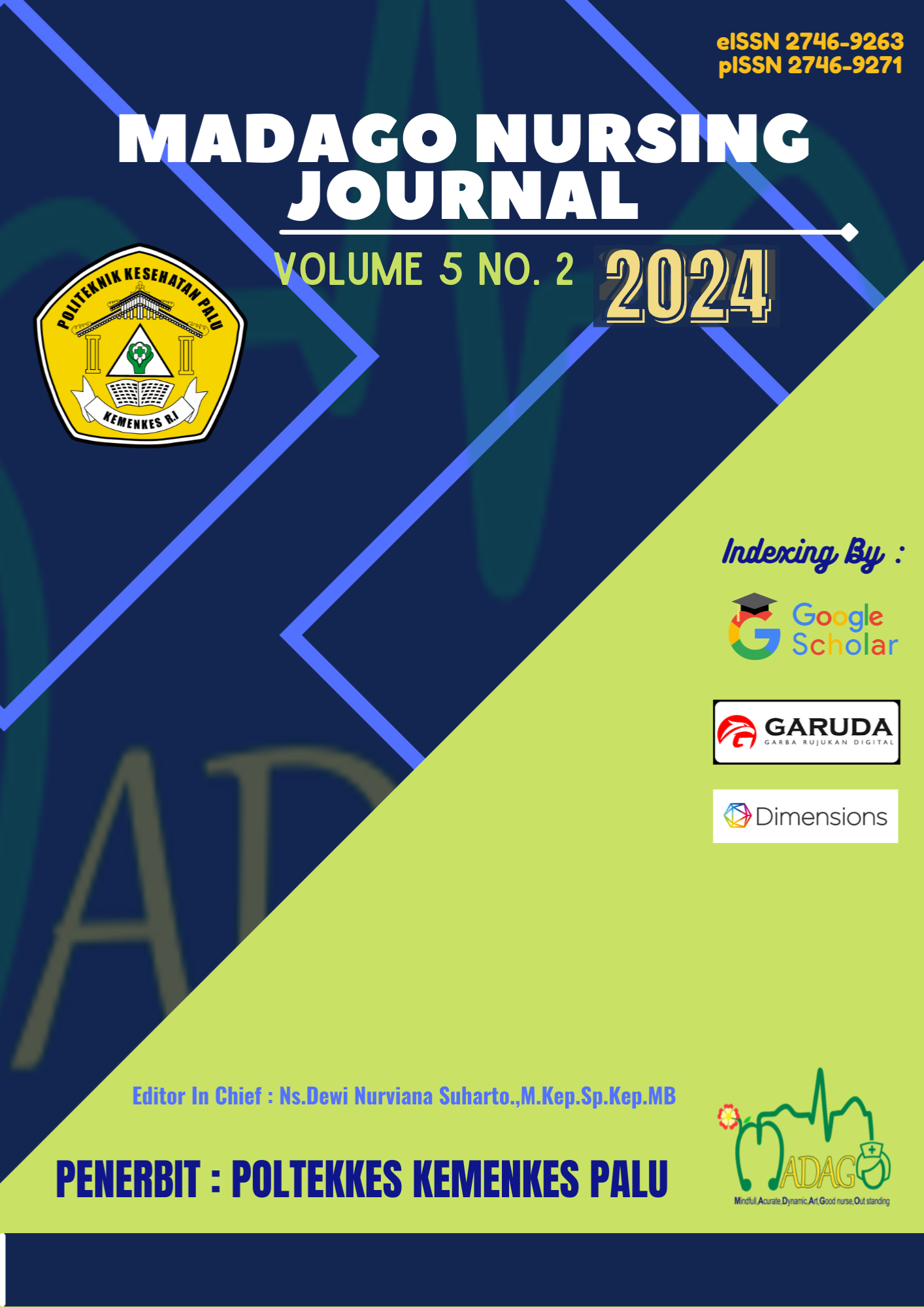Gambaran Empty Nest Syndrome (ENS) Pada Lanjut Usia dI UPT Tresna Werdha Kabupaten Jember
Keywords:
Elderly, Empty nest syndrome, GeriatricAbstract
Introduction: Empty Nest Syndrome (ENS) is at risk for the elderly who are separated from their children, especially those who live in Tresna Werdha Social Care institutions. This study aimed to describe the overview of ENS experienced by the elderly in Tresna Werdha Social Care institutions, Jember Regency Methods: The research design used is a descriptive survey. The sampling technique used is total sampling. The sample used in this study was 72 elderly who were selected based on inclusion and exclusion criteria. Data were collected using the Empty Nest Syndrome questionnaire to measure the overview of ENS in elderly. Data analysis was performed by one sample Kolmogorov-smirnov with a significance level of 0.05. Results: The result showed that there was no significant difference in the level of empty nest syndrome but in the high category (Md (P₂₅-P₇₅)= 114,0 (108,0-120,75); Z= 0,080; p-value 0,200). Majority respondents got high level of ENS with a total of 38 respondents (52,8%). Conclusion: This study concludes that empty nest syndrom ENS remains relatively high in erderly. However, elderly people who stay more than 1 year experience low ENS.
References
Afriansyah, A., & Santoso, B. M. (2019). Pelayanan Panti Werdha Terhadap Adaptasi Lansia. Responsive : Jurnal Pemikiran Dan Penelitian Bidang Administrasi, Sosial, Humaniora Dan Kebijakan, 2(4), 190–198. https://jurnal.unpad.ac.id/responsive/article/view/22925/12609
Cheng, P., Jin, Y., Sun, H., Tang, Z., Zhang, C., Chen, Y., Zhang, Q., Zhang, Q., & Huang, F. (2015). Disparities in prevalence and risk indicators of loneliness between rural empty nest and non‐empty nest older adults in C hizhou, C hina. Geriatrics & Gerontology International, 15(3), 356–364. https://doi.org/10.1111/ggi.12277
Dharmawati, M. A. (2016b). Upaya-Upaya Mencegah Sindrom Sarang Kosong Pada Lanjut Usia Perempuan Di Banguntapan, Bantul. E-Journal Bimbingan Dan Konseling, 11(5), 466–474.
Fitriana, L. N., Lestari, D. R., & Rahmayanti, D. (2021). Hubungan Antara Aktivitas Fisik Dengan Tingkat Kesepian Pada Lanjut Usia Di Karang Lansia Bahagia Banjarmasin. Dunia Keperawatan: Jurnal …. https://www.academia.edu/download/87816726/pdf.pdf
Gao, M., Li, Y., Zhang, S., Gu, L., Zhang, J., Li, Z., Zhang, W., & Tian, D. (2017). Does an Empty Nest Affect Elders’ Health? Empirical Evidence from China. International Journal of Environmental Research and Public Health, 14(5), 463. https://doi.org/10.3390/ijerph14050463
Guadalupe-Tixi, P. (2024). Psychotherapeutic Intervention Plan to Reduce the Emotional Effects of Empty Nest Syndrome in Older Adults. Psiquemag, 13(1), 42–56. https://doi.org/10.18050/psiquemag.v13i1.2679
Handoyo, C. I. D., & Agustina. (2023). Gambaran Resiliensi Pada Orang Tua Yang Mengalami Empty Nest Syndrome. Jurnal Muara Medika Dan Psikologi Klinis, 03(02), 125–129. https://doi.org/10.24912/jmmpk.v3i2.27782
Hasanah, A. U. (2012). Hubungan antara Dukungan Sosial Keluarga dengan Kesepian pada Lanjut Usia di Panti Sosial Tresna Werdha Gau Mabaji Gowa. Universitas Islam Negeri Alauddin Makasar. https://core.ac.uk/download/pdf/198219187.pdf
Leonardo, L., Ose, T., & Goa, L. (2021). Pelaksanaan Pastoral Care Untuk Orang Lanjut Usia di Panti Karya Asih Lawang. In Theos: Jurnal Pendidikan …. https://journal.actual-insight.com/index.php/intheos/article/view/1195
Mahmoudpour, A. (2023). Cognitive flexibility and emotional self-regulation of the elderly with Empty nest syndrome: Benefits of acceptance and commitment therapy. Health Science Reports, 6(7). https://doi.org/10.1002/hsr2.1397
Raile, M., Alligood, T., & Marriner, A. (2020). Nursing theorists and their work. Elsevier.
Rimawati, R. (2016). Pemberdayaan Kesehatan Lanjut Usia di Posdaya Ontoseno Puton, Trimulyo, Jetis, Bantul, Yogyakarta. E-Societas: Jurnal Pendidikan Sosiologi. https://journal.student.uny.ac.id/index.php/societas/article/download/4014/3675
Santos, R. I. M. Dos. (2021). Empty nest syndrome: Experiences of elderly people at the university of maturity project in amapÁ. Ciencia y Enfermeria, 27. https://doi.org/10.29393/cs27-14sdra60014
Su, D., Wu, X.-N., Zhang, Y.-X., Li, H.-P., Wang, W.-L., Zhang, J.-P., & Zhou, L.-S. (2012). Depression and social support between China’ rural and urban empty-nest elderly. Archives of Gerontology and Geriatrics, 55(3), 564–569. https://doi.org/10.1016/j.archger.2012.06.006
Sulha, A. A., Aniqunnahik, M., & Nihayah, U. (2024). Self Acceptane Sebagai Solusi Empty Nest Syndrome Pada Lansia. Jurnal Bimbingn Penyuluhan Islam, 6(1), 22–32.
Utami, P. L., & Puspitadewi, N. W. S. (2014). Perbedaan tingkat stres ditinjau dari empty nest syndrome dan status ibu. Character: Jurnal Penelitian Psikologi., 2(2), 301–302.
Wang, L., Shentu, Q., Xu, B., & Liang, Y. (2020). The prevalence of anxiety on the empty-nest elders in China. Journal of Health Psychology, 25(2), 152–160. https://doi.org/10.1177/1359105318776727
Xu, W., Li, Z., Pan, Z., He, R., & Zhang, L. (2020). Prevalence and associated factors of self-treatment behaviour among different elder subgroups in rural China: a cross-sectional study. International Journal for Equity in Health, 19(1), 32. https://doi.org/10.1186/s12939-020-1148-2
Yulia, Y. (2021). Perbedaan Empty Nest Syndrome Pada Pria Dan Wanita Dewasa Madya Di Desa Serai Wangi Kecamatan Talang Muandau [Universitas Islam Riau]. http://repository.uir.ac.id/id/eprint/8850
Zhai, Y., Yi, H., Shen, W., Xiao, Y., Fan, H., He, F., Li, F., Wang, X., Shang, X., & Lin, J. (2015). Association of empty nest with depressive symptom in a Chinese elderly population: A cross-sectional study. Journal of Affective Disorders, 187, 218–223. https://doi.org/10.1016/j.jad.2015.08.031
Zhang, Y. (2020). Are Empty-Nest Elders Unhappy? Re-examining Chinese Empty-Nest Elders’ Subjective Well-Being Considering Social Changes. Frontiers in Psychology, 11. https://doi.org/10.3389/fpsyg.2020.00885
Published
How to Cite
Issue
Section
Copyright (c) 2024 Tantut Susanto, Ananto Adi Prasetyo, Fahruddin Kurdi, Wahyuni Fauziah

This work is licensed under a Creative Commons Attribution-ShareAlike 4.0 International License.





